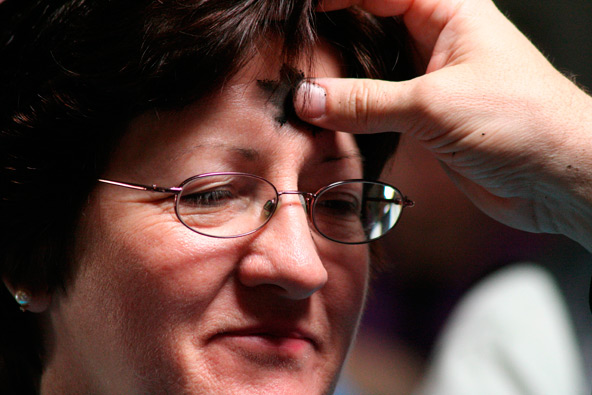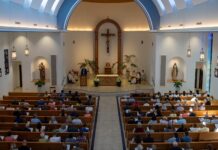
For many Catholics, Lent involves giving up coffee, chocolate or other guilty pleasures. Others forgo television or commit to attending daily Mass.
The 40 days that stretch between Ash Wednesday and the onset of the Easter Triduum on Holy Thursday are set aside each year as a way for the faithful to draw closer to God through prayer, fasting, almsgiving and acts of penance.
Blessed John Paul II, in his apostolic exhortation “Reconciliation and Penance,” emphasized the importance of self-mortification.
Penance, the late pontiff said, is “an effort to put off the old man and put on the new… to overcome in oneself what is of the flesh in order that what is spiritual may prevail.” These acts of sacrifice, he said, help to re-establish the harmony with God that was broken by sin.
Bishop Thomas J. Olmsted has called on Catholics to abstain from meat and offer penitential acts on all Fridays of the year — not just during Lent — for the protection of human life, marriage and religious liberties. He said that Lent in particular offers Catholics an opportunity to experience a conversion of heart.
“Any time we deal with penance, we are talking about something aimed at conversion of heart,” the bishop said. Conversion, he said, means turning away from the darkness and turning toward the light — turning away from what is wrong and turning toward what is right.
“A true conversion helps us become more focused on Christ and on goodness and beauty and truth,” he said. “That’s the purpose of a penance.”
Lives of penance
The five Poor Clares of Perpetual Adoration who live in Tonopah devote themselves to prayer, contemplation and penance. There’s also quite a bit of fasting.
Throughout the year they abstain from meat on Mondays, Wednesdays, Fridays and Saturdays. Lent is completely meatless, but they also take on other penitential practices.
Sr. Mary Fidelis, PCPA, said that she and her sisters increase their prayer time and decrease their recreation in order to get a sense of entering into Christ’s passion. They also pray the Stations of the Cross.
Many lay people, she said, want to know what the Church teaches the faithful are obliged to do during Lent.
“And I think that’s beautiful because we want obviously to follow the Church’s teaching,” Sr. Mary Fidelis said, “but we need to realize the deeper meaning. It’s not just to fulfill an obligation — the Church is inviting us to enter into a deeper communion with Christ.”
In that sense, fasting and mortification are meant to set us free.
“A big part of penance is that it frees us to be with Christ, to allow our passions and our appetites to be subdued by Christ so we can really be with Him and learn from Him and be like Him,” Sr. Mary Fidelis said. “It’s really learning how to imitate our Master.”
Lent, she said, is also an invitation to make reparation for our sins and the sins of the world. Looking at reparation in human terms may make it easier to understand.
“If you see someone who has been hurt, you go to them and say, ‘You are loved,’” Sr. Mary Fidelis said. “With Christ, we’re not trying to reassure Him — He knows everything — we want to love Him for those who don’t love Him. We are saying, ‘We love you and thank you for those who don’t.’”
Some Catholics, she said, may be a bit intimidated by Lent, thinking that fasting and penance will require them to do something beyond their strength. That’s the beauty of the Little Way as taught by St. Therese of Lisieux, who spoke of doing the little things with love.
“Maybe we’re not at the point where we can give up coffee completely, but maybe we cannot put the creamer in,” Sr. Mary Fidelis said. “So it’s taking little steps and to do it with love.”
Acts of penance also might include giving up things we enjoy. That might entail giving up a half hour of television in order to spend a half hour praying the rosary or reading the Bible or the Catechism of the Catholic Church.
“In other words, fasting from something that isn’t bad but replacing it with something else,” Bishop Olmsted said. “Fast from something that you’re accustomed to do or that you enjoy doing and replace it with something else that’s a good use of time.”
Why we fast
First of all, Jesus fasted. By abstaining from meat, eating smaller meals or not snacking, we’re imitating our Lord and Savior Jesus Christ.
In a highly secularized society, people often think of disciplines of the body in terms of what that accomplishes physically. A fuller vision, Bishop Olmsted said, would be to look at what discipline of the body does for us spiritually. Sr. Mary Fidelis agreed.
“Look at someone preparing for a race and how they really mortify themselves both with increasing their exercise and decreasing their eating,” she said. “They go through this training and that all make sense to the world. But we have to look at it as though we are athletes for Christ.”
Chris Zajdzinski, founder of Virtuous Life Ministries, is coordinator of Young Adult Outreach at St. Timothy Parish in Mesa. He said he and many parishioners fast on Tuesdays as part of the community’s effort to bring about the New Evangelization.
“James 4:6 reminds us that God gives grace to the humble, and fasting is a way to humble ourselves and release God’s grace into our lives in a very powerful way,” Zajdzinski said. “When we fast, we are acknowledging that our souls need God’s grace more than our bodies need food.”
Allowing our bodies to go through the physical pain of hunger helps trigger the spiritual understanding of the need to crucify the flesh, he said.
“There is nothing quite like giving up food. There is no substitute for giving up that exact practice,” Zajdzinski said. “We need to recognize all the types of sacrifices we can make and all the things that will help us put to death selfishness in us.”
Bishop Olmsted said that fasting from food is biblically based and can be good for our prayer lives. Since we all eat, he said, fasting can be a good place to start when it comes to penance.
In fasting, “prayer is joined in a bodily action, so soul and body get more closely united,” Bishop Olmsted said. “As Blessed John Paul II reminded us, we are body and soul. There’s a language of the body itself and when the language of the body is speaking the same thing as the language of the soul — when prayer and fasting come together — it puts us more in communion with God and love.”
Sr. Mary Fidelis said that penance can bring about a great flowering of love. The little aspirations of love that we make — remembering not to add the creamer to our coffee, for example — are occasions for us to show God that we love Him.
“Do it for love — do it for Christ,” Sr. Mary Fidelis said. “It doesn’t have to be really huge things, but according to our strength and where we are in the spiritual life.”
-
Canon 1250 All Fridays through the year and the time of Lent are penitential days and times throughout the entire Church.
-
Canon 1251 Abstinence from eating meat or another food according to the prescriptions of the conference of bishops is to be observed on Fridays throughout the year unless they are solemnities; abstinence and fast are to be observed on Ash Wednesday and on the Friday of the Passion and Death of Our Lord Jesus Christ.
-
Canon 1252 All persons who have completed their fourteenth year are bound by the law of abstinence; all adults are bound by the law of fast up to the beginning of their sixtieth year. Nevertheless, pastors and parents are to see to it that minors who are not bound by the law of fast and abstinence are educated in an authentic sense of penance.
-
Canon 1253 It is for the conference of bishops to determine more precisely the observance of fast and abstinence and to substitute in whole or in part for fast and abstinence other forms of penance, especially works of charity and exercises of piety.






